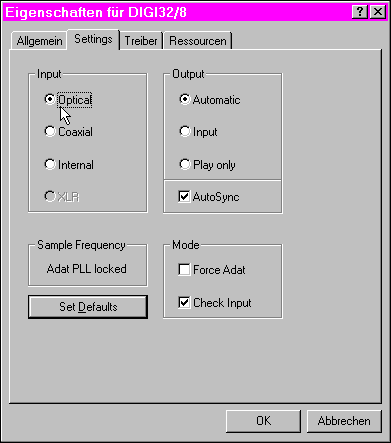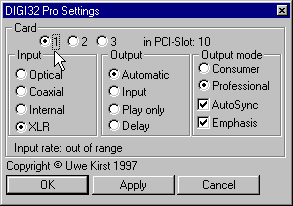 |
DIGI32 SERIES: |
|
 |
 |
|

16/20/24 Bit PCI-Bus Digital In/Out
Card with ADAT® Interface
|
|

|
 |
DIGI32/8 is the
ultimate solution for master and multitrack tasks. The card works exactly
like a DIGI32 with all its advantages, giving you a perfect 2-channel
digital in/out solution. But when the card is treated as 8-track device
(like in Cubase VST, Samplitude or Cakewalk) it switches automatically
to the optical input and into the ADAT mode. So it's possible to transfer
up to eight channels per card (16 with two, 24 with three cards) between
a PC and a ADAT, or any other device equipped with such a port, like
Korg's or Yamaha's digital mixing desks.
To maintain the excellent varispeed performance of the ADAT machine the DIGI32/8
does NOT use wordclock synchronization, like most of Alesis Third Party Developers
do. Instead we decided to use the same PLL method used by Alesis in their ADATs,
the so called Bitclock synchronization. Whatever you do with your ADAT: DIGI32/8 stays
locked and will not loose a sample! |
|

|
| Works as 2-channel stereo (SPDIF) or 8-channel
(ADAT) digital in/out card |
| Full duplex and up to 24 bit in both modes,
with Windows 95 AND NT! |
| Perfect bit clock synchronization |
| Combined Channel Interleave / Multi-device
driver for use with many recording programs |
| 3 inputs switchable during operation |
| Routing to the output changeable during
operation |
| Outputs optical / cinch work simultaneous
(signal distribution possible) |
| Ignores copy protection |
| High sensitive input stage (< 0,2 Vpp
input level) |
| High bus transfer rate (> 120 MByte/s) |
| More than one card with only one driver
useable |
| Inputs and outputs ground-free transformer
coupled |
| Error LED for input signal |
| Low Jitter Design: < 3 ns in PLL mode |
| AutoSync enables perfect recording in
all modes |
| Sample aligned simultaneous start of record
and playback in Record while Play mode |
| Very low system load through 32 Bit memory
transfer and 128 kB fast SRAM |
| Automatic hardware selftest when booting |
| Input optical (TOSLINK), coaxial (Cinch),
internal (CD-ROM or Sync In) |
| Input format SPDIF (Consumer, Professional),
with cable adapter AES / EBU |
| Output optical (TOSLINK), coaxial (Cinch),
internal (Sync Out) |
| Output format SPDIF (Consumer, Professional),
with cable adapter AES / EBU |
|

|
|
|
Using the 'Settings' tab in the device
manager gives you full control over the DIGI32/8. 'Input' lets
you change the actual input. 'Sample Frequency' tells you which sample
rate the signal at the chosen input has (32 kHz, 44,1 khz, 48 kHz,
Out of Range, No Lock.) 'Output' controls the monitoring while recording.
'Automatic' switches the input signal to the output only in record
mode, 'Input' all the time except something is played back, and 'Play
only' helps you to avoid feedbacks as the input signal will never
be passed to the output.
AutoSync allows a constant synchronization to the input signal. 'Force ADAT'
enables evry 'normal' 2 channel software to gain access to the ADAT interface.
All options are available in real-time, without having to reboot or even to
click OK!
Newest drivers on our Download Page
|
 |
|

|
| Our unique Windows
NT driver gives you the same options as the driver for Windows 95!
There is only one driver supporting all cards of the DIGI32 series
in every combination. This includes the DIGI32/8 with up to
8 channels, Full Duplex and up to 24 bit. |
 |
|

|
| 8 bit 1 byte (stereo 2 bytes) (only Windows
NT) |
| 16 bit 2 bytes (stereo 4 bytes) (works
as 32 bit hi-speed transfer) |
| 20 bit 3 bytes MSB (stereo 6 bytes) |
| 24 bit 3 bytes (stereo 6 bytes) |
| 24 bit 4 bytes MSB (stereo 8 bytes) (works
as 32 bit hi-speed transfer) |
| 32 bit 4 byte (stereo 8 bytes) (works
as 32 bit hi-speed transfer) |
|

|
- AutoSync
DIGI32 works exclusively in slave mode. With AutoSync activated it continuously
searches for a valid input signal. So starting a recording on-the-fly is
possible (as well as anytime during playback, thanks to Full Duplex) without
first having to synchronize the card to the input signal. When using more
than one card synchronizing is easy, just spread an input signal to all
inputs. In case of 'local loop-back' operation (for example DAT) AutoSync
leads to a loss of the digital carrier. For this special application AutoSync
can be disabled.
- SyncAlign
When the Record while Play mode is activated, the corresponding software
first starts Record and then Playback (or Playback then Record.) SyncAlign
can compensate the time difference so that an exact simultaneous start
of Record and Playback in the Record while Play mode is guaranteed.
- ChannelSync
To avoid channel swapping in ADAT mode, caused by input errors while using
AutoSync, DIGI32/8 uses a highly reliable and secure technique called ChannelSync.
With this it is impossible to get the channels swapped, even in the worst
cases!
- SuperFast
As a PCI bus card DIGI32 of course works in 32 bit mode. Instead of being
snagged with slow DMA transfer, slow multiple 16 bit transfers using I/O
addresses, non-linear memory transfer, or the non-usage of an IRQ (an attempt
to get rid of resource problems at the cost of performance and data integrity)
DIGI32 uses a linear memory transfer with the full copy speed of modern
PC systems. 32 bit data pass the CPU in one cycle, being transferred to
the hardware with PCI-bursts. The software is able to send its data without
any waitstate. The effective system load is almost zero, which can be shown
easily when using more than one DIGI32 in one system.
- Hi-Performance
Normally the designer of hardware does not have any influence in the functions
of his product, because all features are the result of the chips used.
This is not only true for several features, but also for the data format
between the hardware, the PC and the software. Usually a large driver is
needed to correct, map or translate all these things. But all actions of
the driver are also actions of the CPU, ending in a high system load. DIGI32
is different. DIGI32 is made out of a FPGA, a completely programmable chip.
Thus a piece of hardware was created which works exactly the way a perfect
Digital In/Out card should work and behave. The driver of the DIGI32 does
not result in any slowing down the data transfer, because it has nothing
else to do than to configure the user's options.
- Hardware Selftest
When loading the driver (while booting Windows) DIGI32 performs a hardware
selftest. This test was originally only used in production test procedure,
but as it lasts only a few hundredths of a second we decided to integrate
it into the Windows driver. Therefore you can always be sure when working
with Digi32 that all bits are fully functional. In case of an error a message
is displayed.
|

Copyright © 2002 RME. All rights reserved.
RME is a registered trademark.
This website contains names and marks of other companies.
|


